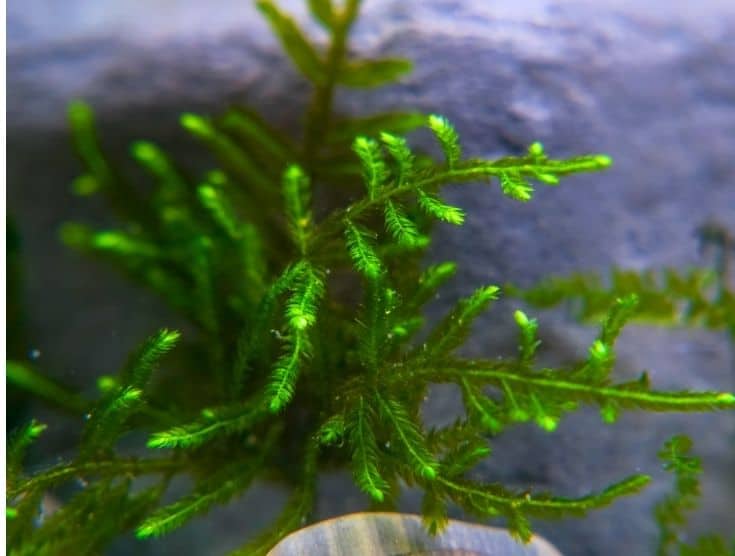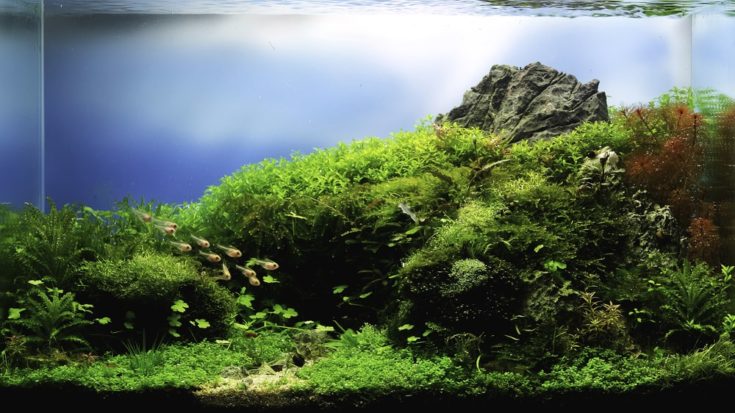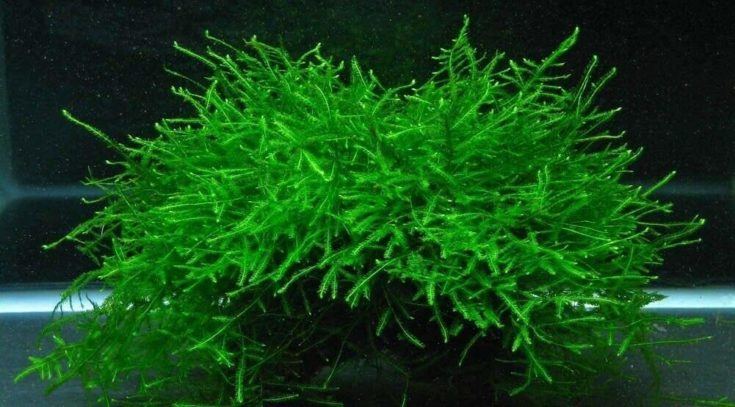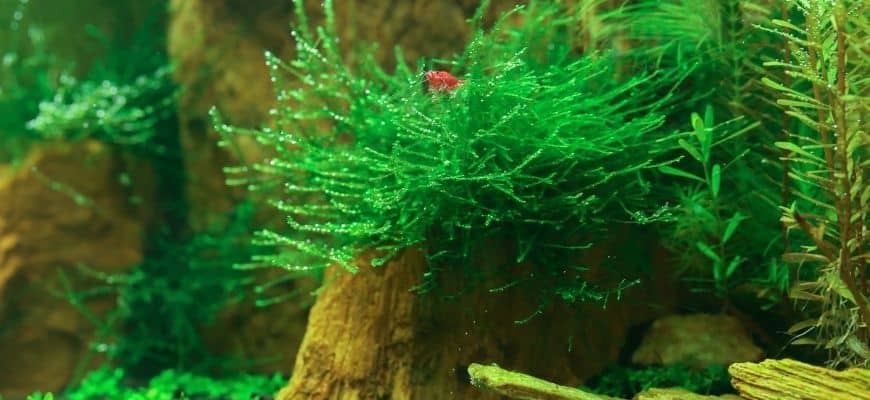What’s the difference between Christmas moss and Java moss? And which plant is the best choice for your tank?
Both plants are extremely popular with aquarists, providing a natural filtration system for your tank water to keep it safe and clean for your fish and offering shelter for shy fish species and vulnerable fry.
In this comprehensive comparison guide, we discuss Christmas moss vs. Java moss in detail so that you can decide which one to pick for your aquarium.
What’s The Difference Between Christmas Moss and Java Moss?
Java moss and Christmas moss are both popular aquatic plants that are considered easy to grow.
Of the two, Java moss is generally regarded as the easiest to look after. The plant is extremely tolerant of most water conditions and is considered to be the best choice for low-light, low-tech tanks. Christmas moss grows quite slowly and needs quite a lot of light and CO2 supplementation to stimulate more vigorous growth and promote vibrant color.
Java moss is the best choice as a filler plant, whereas Christmas moss typically grows flat and can be used to cover driftwood, rockwork, etc.
Comparison Table
Java Moss

Temperature
70° – 75° F
Pruning
Trim occasionally to prevent overgrowth
Growing Speed
Slow to medium
Light
Low to medium light
Water hardness
6 – 20 dGH
Location
Attach to rocks, driftwood, etc
Christmas Moss

Temperature
68° – 82° F
Pruning
Trim occasionally to prevent overgrowth
Growing Speed
Slow
Light
Medium to high light
Water hardness
5 – 15 dGH
Location
Attach to rocks, driftwood, etc
Now, let’s make a detailed direct comparison between Christmas moss and Java moss.
What Are Aquatic Mosses?
All moss species are classified as bryophytes that have no vascular tissues. That physiology prevents the plants from growing to more than just a few inches in height.
Aquatic mosses don’t produce flowers or seeds. To spread, the plants produce spores that are carried through the water until they reach a suitable spot in the tank where they can germinate.
Benefits Of Aquatic Moss
Christmas moss and Java moss both look beautiful in your fish tank, but they bring other benefits, too.

Like all plants, these mosses extract nitrates and other nutrients from the water column, lightening the biological load on your filtration system and helping to improve the water quality in your tank. Mosses also generates oxygen and absorbs CO2 from the water, helping to oxygenate the tank for your fish.
If you have a breeding tank, both these species of moss can be extremely useful. They both make an excellent spawning medium for egg-scatterers, and newly-hatched fry can take shelter within the mosses’ fronds until they grow large enough to be safe from potentially predatory fish.
Also, the microscopic organisms that provide food for newborn fry grow readily on mosses, as do biofilm and beneficial bacteria that process the waste products in the water.
Are Christmas Moss And Java Moss The Same Plant?
Although Java moss and Christmas moss look very similar at first glance, they are actually two separate species of plants.
Confusion also arises over Java moss’ scientific name. The plant was formerly known as Vesicularia Dubyana, although it was recently reclassified as Taxiphyllum Barbieri. Unfortunately, Vesicularia Dubyana is also known as Christmas moss, so, when buying these mosses, I advise you to always use the Latin name to avoid any confusion.
Christmas Moss
Christmas moss is so named for its triangular leaves that make the plant look like a miniature fir tree.
The plant originates from Brazil, although it is available worldwide and is a popular addition to many home fish tanks. In the aquarium, Christmas moss is generally used by aquascapers to create a carpet or a wall. The plant is also included in many setups to remove nitrogen.
In comparison to Java moss, Christmas moss is a slow-grower with totally different water requirements.
Appearance
Christmas moss has dark green leaves that resemble fir trees, hence the plant’s common name.
The plant has a creeping habit, growing horizontally rather than vertically and forming mats. The moss’ leaves are oval or round, terminating in a sharp point, and growing at right angles to the plant’s stem. The low-growing plant reaches just four inches in height when fully grown.
Water Conditions
Christmas moss requires warmer water than Java moss, and it also needs much brighter lighting.
The ideal water temperature for Christmas moss is between 66° and 78° Fahrenheit. Water pH can be in the range of 5.5 to 8.0, with a water hardness of 5 to 15 dGH.
Growth Rate
Christmas moss grows more vigorously and quickly when the water is warmer.
Since the plant tends to grow flat, it’s ideal for coating rocks and driftwood, eventually covering them completely to create a beautiful underwater jungle effect. Many aquascapers also use Christmas moss to carpet the substrate.
CO2 and fertilizers can be used to boost growth but that’s not always effective with a plant that grows so slowly, and excessive amounts of CO2 can encourage algal growth.
Maintenance
Christmas moss needs trimming every so often to keep it tidy, and that can also help to keep the plant healthy.
Java Moss
Java moss comes from Southeast Asia and is just about the most popular species of aquarium moss in the trade.
The moss is very easy to grow and is extremely hardy, surviving and thriving in harsh water conditions that would kill most other plants. Java moss grows best when attached to some kind of structure in your tank, such as rockwork, driftwood, etc. The plant prefers a fairly strong current, too, so if you don’t fix the moss to something, it will most likely attach itself to your filter box or tubing.
Appearance

Java moss is a delicate plant that has small branched stems and irregular leaves. The plant’s stems are covered in small, long, oval-shaped leaves that grow over each other. The plant is bright green underwater, making it a very popular choice for aquariums.
The plant uses short filaments called rhizoids to fix itself to surfaces within the aquarium. The rhizoids cannot absorb nutrients for the plant. Thanks to an absence of roots, Java moss takes up the nutrition it needs via its leaves and stems.
Water Conditions
Java moss is a versatile, hardy plant that can tolerate many different water conditions.
The plant will grow in temperatures varying from 57° to 86° Fahrenheit, although 70° to 75° Fahrenheit is preferred and will produce the brightest color. pH can be anything from 5.5 to 8.0, and water hardness can be up to 20 dGH.
Growth Rate
Java moss has a slow-to-medium growth rate and needs very little light, whereas Christmas moss needs much more light and is a slower grower.
The plant grows very dense and thick once it’s established. So, you must trim the plant regularly to enable water to circulate throughout the growth, otherwise, parts of the moss will start to die off.
Maintenance
Java moss doesn’t really need fertilizer, but if you do use CO2 in your aquarium, you’ll enjoy a faster growth rate.
Like Christmas moss, to keep Java moss tidy, you simply need to trim it from time to time with a pair of aquascaping scissors. Don’t disturb the plant too much until it has become established, or you risk retarding growth.
What Are The Pros And Cons Of Christmas Moss Vs. Java Moss?
There are a few pros and cons to both these species of aquarium moss:
Christmas Moss Advantages
- Christmas moss makes a wonderful carpet plant and it can also be used to cover the sides of the aquarium, piece of driftwood, and rocks.
- The plant is readily available and is relatively inexpensive to buy.
And Disadvantages …
All mosses are prone to problems with algae, and Christmas moss is no exception.
If the water quality is poor, your tank is exposed to sunlight, or you leave the lighting on for too many hours per day, you could find algae growing in the moss. However, if you include a few natural algae eating fish or invertebrates in your setup, they can help to keep algae blooms under control.
Another problem with Christmas moss is that if you don’t trim it, the leaves might turn brown and die off.
You can also find that happening when you first introduce the plant to your tank. However, once the moss settles in and becomes acclimated to the new environment, the problem should resolve itself. Temperature changes and fluctuations in the water conditions can also cause leaves to die-off.
Java Moss Advantages
- Java moss is easy to grow and the plant is pretty undemanding when it comes to water conditions.
- The moss is readily available and inexpensive to buy.
- You can use Java moss to create a carpet in your aquarium or train it to grow over tank decorations if you want to. You can even create “trees” with this moss by using aquascaping glue to stick pieces of moss to an upright piece of driftwood.
And Disadvantages …
The only major problem with Java moss is that just like Christmas moss, it is prone to algae growth.
However, if you look after your tank properly and keep it clean, algae shouldn’t be a problem. Algae can be an issue if you use CO2 to boost plant growth too. Although a small amount of algae in your tank isn’t an issue and can be a food source for fish and invertebrates, too much can be a big problem.
If algae get well-established and deeply embedded in your Java moss, it’s almost impossible to get rid of. In that case, your best option is to remove the moss and begin again with a new plant.
In Conclusion

I hope you enjoyed this comparison guide to Java moss and Christmas moss. If you did, please share the article with other aspiring aquascapers!
Both plants look quite similar and are sometimes mistaken for the same species. When you’re buying these mosses, double-check that you’re purchasing the correct species. Java moss is happiest in cooler water than Christmas moss that grows best in warmer temperatures.
Do you have Java moss or Christmas moss? Perhaps you’ve been successful in keeping both plant species?
Tell us about your moss-keeping achievements in the comments box below!